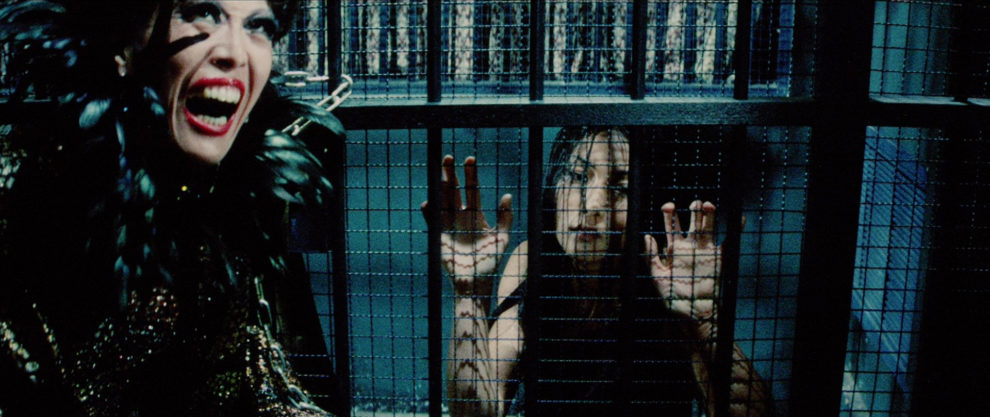Over the course of two features, “Female Prisoner 701: Scorpion” and “Female Prisoner Scorpion: Jailhouse 41”, director Shunya Ito had made two of the most beloved entries within the exploitation genre, in Japan and worldwide. Indeed, the character of Nami Matsushima, nickmamed “Sasori” (“Scorpion”), played by Meiko Kaji, would continue to become something of a pop-culture phenomenon given her looks, her sense of style, but most importantly of all as an icon of womanhood within the genre. In “Female Prisoner Scorpion: Beast Stable” Ito and his main actress explored more facets of Nami's world in which she again is the one being hunted, the person whose mere existence poses a threat and some kind of rebellion to the status quo. As the former entry had emphasized Nami's status as a representative of women being exploited, abused and violated, in this third entry she becomes a much stronger presence, a shape or ghost, bound to appear anywhere at anytime.
After the events of the last movie, Nami (Kaji) is still on the run from the law, content on living in hiding and making a modest living for herself, working as a seamstress. However, with the walls of the city plastered with Wanted-sheets showing her face it is only a question of time when the police might catch up with her, for example, Detective Kondo (Mikio Narita), who lost his left arm while chasing after Nami. The hunt for the escaped convict has become more of a personal vendetta for him, as he demands his men to leave no stone unturned in the pursuit of Matsushima.

Meanwhile, Nami has run into Yuki (Yayoi Watanabe), a prostitute who feels obliged to take care of her mentally handicapped brother, providing him with food and drink, while also taking care of his nearly insatiable sexual appetite. Her attempts to help Yuki, however, ultimately result in a conflict with the yakuza controlling the city's red-light district, especially the girlfriend of their leader, a woman named Katsu (Reisen Lee), who has her own score to settle with Nami since she has made her life a living hell when they were both in prison many years ago. With the yakuza looking for “Sasori” and the police closing in on her location, she must once again use all her strength and wits to escape her pursuers, and punish them for what they did to her and others.
Considering the concept of the trilogy, much can go wrong in the third part, the conclusion of the journey of a character. Although the series would go on to have one more entry, albeit from a different director, as an ending to the original story “Beast Stable” works quite well in many ways. It is also clear from the very first moments the viewer meets Nami again how Kaji has mastered the part, and has become more confident in the ways she portrays this woman. Similar to other roles she played in the 1970s, her expressive performance is reminiscent of the expressive features of silent movie actors, with especially her eyes communicating to the point her character's feelings of compassion and the deep hate she harvests inside, which at one point will explode, much like a scorpion waiting for the right moment to strike and kill its prey. So much about her character is about this drive towards freedom and independence, but there seems to be a growing realization within her that perhaps these features are not meant for her or for women in general. Nami has become a symbol for that drive, but also for these feelings of fury and frustration, making her in many ways the executioner for a revenge which is directed at the very heart of a deeply dysfunctional system.
Although the Japanese flag as a metaphor for the nation is absent in “Beast Stable”, the social commentary is still there and just as acidic as it has been in the previous features. Masao Shimizu's cinematography along with Osamu Tanaka's feverish editing complete the image of a patriarchal society deeply corrupted and fragmented, perhaps best represented by Mikio Narita's performance as Kondo who may not be the most despicable, but at least the most malevolent antagonist of the series, a man who knows his way around the system and how to use it for his own brutal vendetta.
“Female Prisoner Scorpion: Beast Stable” is a worthy third entry to the series and a great conclusion to the journey of the main character. Again supported by a strong leading performance by Meiko Kaji, along with a great visual concept and interesting ideas, Shunya Ito has succeeded in demonstrating how the exploitation genre is able to make poignant observations about social and political developments which to this day remain relevant.

















The drive scorpion jacket made its debut as a character in its own right, adorning Ryan Gosling’s enigmatic Driver in the eponymous film. Designed by costume designer Erin Benach, it was an instant standout. The jacket’s design was minimalist yet powerful: a sleek white satin shell, a bold scorpion embroidered on the back, and a fitted silhouette that exuded a sense of mystique and danger.